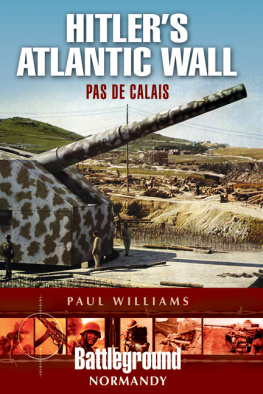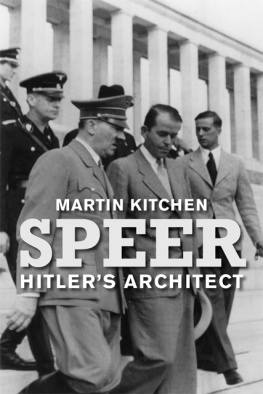


Page 2: Less spectacular than some of Speers endeavors, but enduring in their own way, were Dr. Todts sprawling autobahns. A hundred years hence, Speers reputation may well rest on his wartime ministry and postwar books, while Dr. Fritz Todt will be ranked as one of the worlds most renowned road builders. (HHA)
Page 3: Reich Chancellor Adolf Hitler with his two future Armaments Ministers, Drs. Fritz Todt (center, in civilian suit) and Albert Speer (far right, in profile) on a 1936 visit to Dsseldorf to inspect the model of an autobahn bridge. At the time, the much more renowned Dr. Todt was the chief building engineer for the Third Reich, while the younger Dr. Speer was General Building Inspector for Berlin (in 1937). (HHA)
Right: Part of Speers ethereal show of light and dark over top of a Nuremberg Nazi Party Congress, 1938, which British Ambassador to Berlin Sir Neville Henderson termed a cathedral of ice in his wartime memoirs. (HHA)
Published in the United States of America and Great Britain in 2010 by Casemate Publishers
908 Darby Road, Havertown, PA 19083
and
17 Cheap Street, Newbury RG14 5DD
Copyright 2010 Blaine Taylor
ISBN 978-1-932033-68-7
eISBN 9781935149774
Cataloging-in-publication data is available from the Library of Congress and the British Library.
All rights reserved. No part of this book may be reproduced or transmitted in any form or by any means, electronic or mechanical including photocopying, recording or by any information storage and retrieval system, without permission from the Publisher in writing.
10 9 8 7 6 5 4 3 2 1
Printed and bound by Printworks International.
For a complete list of Casemate titles please contact:
CASEMATE PUBLISHERS (US)
Telephone (610) 853-9131, Fax (610) 853-9146
E-mail: casemate@casematepublishing.com
CASEMATE PUBLISHERS (UK)
Telephone (01635) 231091, Fax (01635) 41619
E-mail: casemate-uk@casematepublishing.co.uk
D EDICATION
To those who helped make this book possible: mentor P. James Kurapka, Gate City, VA; translator Erika Burke, Pearland, TX; and photographer John Durand, Towson, MD, all USA. Such a detailed work as this is truly the sum of all its many parts!
A CKNOWLEDGMENTS
This study is the result of almost five decades of research, but would not have been possible without the valuable help of many people, all of whom I want to mention by name.
First, there is my publisher, David Farnsworthand my editor, Steven Smithfor agreeing to undertake the project, and for having patience with me while I completed the book after it was due. Just as, without the engineers and architects there would be no roads and no buildings, so, also, without them, there would be no author, and no book. Second, there are the entire photographic staffs at both the Library of Congress in Washington, DC and the United States National Archives at College Park, MD, as well as many other private and museum sources worldwide, credited where their photography and artwork appear.
The photographs would not exist without the excellent pictorial consulting of Stan Piet of Bel Air, MD, and the artistry of John Durand of Towson, MD. Also joining the ranks of those helping me with this project was Rene Klish, Curator of the US Army Combat Art Collection at Fort Lesley J. McNair in Washington, DC. My friend, architect Paul Gorman of Towson, MD, aided in my understanding of various engineering and architectural matters and terms. Lisa Julius of Towson, MD, transcribed the captions of several wartime videos.
As with prior volumes, Mrs. Erika Burke served as my German translator, and both P. James Kurapka of Gate City, VA, and Ray and Josephine Cowderry of North Dakota brought important new Todt and Autobahn photo collections to my attention. Ruth Sheppard in the UK was the copy editor, while Frank White of Towson, MD, and Tara Lichterman of Casemate were computer consultants.
Also, kudos to the wonderful research staff at Baltimores Enoch Pratt Free Library, and Towsons Baltimore County Library.
My thanks to them all!
AUTHORS PREFACE
I first began reading books on Nazi Germany about the time of the 1960 publication of William L. Shirers The Rise and Fall of the Third Reich , which I reviewed later in my Calvert Hall High School literary magazine. This capped my interest in all of the various postwar movies and television documentaries on the war and the Nazis that appeared over the previous decade. Since all of the books that I read left many unanswered questionswritten as they were either by observers of the events or authors working with second-hand informationby the time I reached Towson State College in 1968, Id just begun to do what our history professors urged us to: Go back to the original sources, the memoirs of the actual participants themselves.
None were more interesting than those of Dr. Albert Speers, Inside the Third Reich: Memoirs , which I reviewed for my college student paper, Towerlight . It answered many questionsbut not all. Six years later, I reviewed Professor Speers second book, Spandau: The Secret Diaries , for the then Baltimore News American newspaper, as I did his third and last postwar published book, Infiltration: How Heinrich Himmler Schemed to Build an SS Industrial Empire in 1981.
In those first readings, I was inclined to give Speer the benefit of the doubt, to accept his account of things as the way they actually were; I even wrote to him for an autographed pictureand received it. In the 1990s, I read all three books over again, as well as several others debunking Speers own accounts. In the preparation for the current volume, I read all of them yet a third time over.
From these multiple readings, I have come to some conclusions. Far from being the apolitical, artistic technician that he claimed to be until the time of his death, Speer was, in fact, a practitioner of the very highest order of Nazi politics and manipulation. He was also an accomplished actor and liar: he knew all about the Holocaust from the very start, as did, indeed, all the other top Nazi leaders. That is why he was treated as such a pariah at both Nuremberg and Spandau by his fellow convicted and accused war criminals: they knew what a phony he was, having observed him in Hitlers presence for almost 15 years.
Thus, the current volume will entirely dispense with all the handwringing, back-and-forth what-did-he-know-and-when-did-he-know-it? soul-searching of the last few Speer biographies. Based on all of my reading from all sources, and my 63 years of military, business, and political life in a modern, industrialized, technocratic, Western state, Ive come to the inescapable conclusion: he knew .
That having been said, this book marks a radical departure from all my previously published volumes in one important respect. In them, I baldly stated the facts as I found them, and then let the reader decide. I shall do the same here, but with the following major change: I shall state all sides of an issue, but also give my own considered view. The reader will still be free to make his or her own decision.
I also contest Dr. Speers assertion that the job of Minister of Armaments found him, rather than the other way round. It is my contention that he actively sought some such high post following the great German military victories of that high tide summer of Nazi victory of 1940, realizing as he did that only through such a top position could he not only maintain his standing within the Nationalsozialistische (National Socialist or NS/Nazi) hierarchy, but actually advance it, especially in the expected postwar Nazi world order that he, and others, felt sure was coming. Therefore, he could not allow himself to remain forever simply Hitlers architect, despite his protestations to the contrary in all his published postwar books.

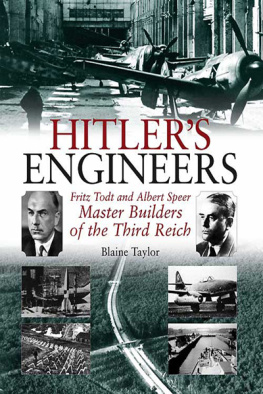

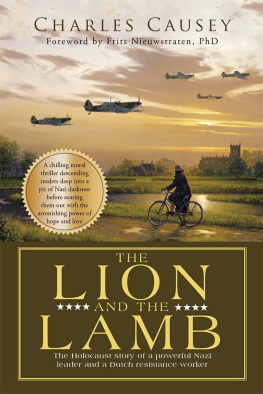

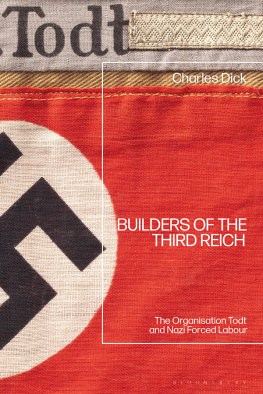
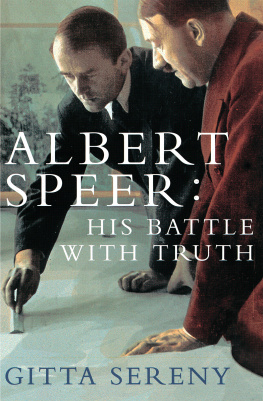
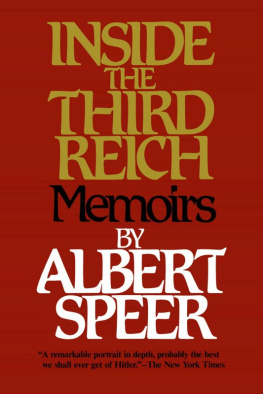

![Russell - Leaping The Atlantic Wall - Army Air Forces Campaigns In Western Europe, 1942-1945 [Illustrated Edition]](/uploads/posts/book/94591/thumbs/russell-leaping-the-atlantic-wall-army-air.jpg)
